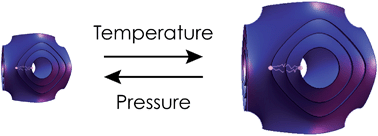Temperature and pressure tuneable swollen bicontinuous cubic phases approaching nature's length scales†
Abstract
Bicontinuous cubic structures offer enormous potential in applications ranging from protein crystallisation to drug delivery systems and have been observed in cellular membrane structures. One of the current bottlenecks in understanding and exploiting these structures is that cubic scaffolds produced in vitro are considerably smaller in size than those observed in biological systems, differing by almost an order of magnitude in some cases. We have addressed this technological bottleneck and developed a methodology capable of manufacturing highly swollen bicontinuous cubic membranes with length scales approaching those seen in vivo. Crucially, these cubic systems do not require the presence of proteins. We have generated highly swollen Im3m symmetry bicontinuous cubic phases with lattice parameters of up to 480 Å, composed of ternary mixtures of monoolein, cholesterol and negatively charged lipid (DOPS or DOPG) and we have been able to tune their lattice parameters. The swollen cubic phases are highly sensitive to both temperature and pressure; these structural changes are likely to be controlled by a fine balance between lipid headgroup repulsions and lateral pressure in the hydrocarbon chain region.

- This article is part of the themed collection: Celebrating the 2017 RSC Prize and Award Winners

 Please wait while we load your content...
Please wait while we load your content...